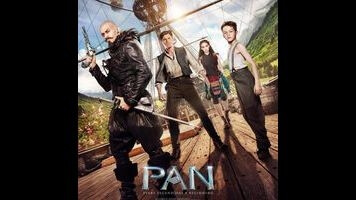In the middle of the London Blitz, devious nuns sell orphan Peter Pan to a band of space pirates (some of whom are also clowns), who whisk him away to the mines of Neverland and the domain of Blackbeard, a time-traveling fascist dictator who huffs down crushed rock-form fairy dust in a vaporizer mask. Blackbeard has picket-fence teeth and skin like chalk, and he hops around in a suit of armor and calf-high red stockings while his pirates and child slaves bray “Smells Like Teen Spirit” from the mine pits below. His flying ships, fitted with searchlights, patrol Neverland, a volcanic island suspended in an expanse of interstellar cloud—home to bioelectric mermaids, flocks of flying fish, and natives who wear combat boots and yarn and bleed colored dust.
Hugh Jackman, nominal star of Pan, plays Blackbeard as a towering diva, bald head covered in a discount Bela Lugosi wig, beard styled into a Van Dyke. Somehow, he isn’t even the strangest presence in the movie, at least not as long as Garrett Hedlund is on screen, playing Captain Hook as “Indiana Jones with severe lockjaw.” And neither of them really stands a chance against a backdrop that is effectively one big 3-D toy theater of kitsch and derivative aesthetics. (Reference points here include, but are not limited to: Moulin Rouge, X-Men: First Class, The Adventures Of Baron Munchausen, and 1941.) In short, there is a lot going on here, and none of it has jack to do with J.M. Barrie’s Peter Pan, Or The Boy Who Wouldn’t Grow Up.
Having chucked out everything that makes Peter Pan what it is (i.e., all that stuff about childhood, growing up, and make-believe), writer Jason Fuchs and director Joe Wright instead twist it into the kind of fairy-tale blockbuster that audiences seem to like, or at least tolerate: The one about the capital-C, capital-O Chosen One who is destined to defeat some big bad villain. (Cue talk of “The Pan,” prophesied savior of Neverland, whose parents died fighting Blackbeard and who will be known by his pan-pipe necklace and ability to fly, etc., etc.) Here, one could make the same points that have been made over and over about all the other movies and YA franchises in which protagonism is an inherited condition; perhaps it’s better to just note that a hero without agency isn’t really a hero, and move on. The thing about clichés is that it’s hard to say anything new about them.
Wright’s last movie, the Tom Stoppard-scripted Anna Karenina, was a heap of façades, theatrical devices, and expressionist effects scrambled with tony melodrama—an unusual adaptation, though not necessarily a personal one, with a surplus of motifs that never quite flourished into themes. (See also: Wright’s earlier Hanna, a movie in which fairy-tale imagery symbolized… fairy tales.) Turning Peter (newcomer Levi Miller) into a generic questing boy hero leaves a whole lot of blank space, which Pan covers in elaborate, eye-catching doodles—an escape via steampunk cable car here, a Ramones musical number there, and an extended animated sequence to top it all off. Sometimes, the aspect ratio switches so that swords can pop out over the edge of the frame; at other points, the color palette gets graded down into the cyan-and-warm-tones look of primitive two-strip Technicolor, à la The Aviator.
It’s hard to make the case that any of this means anything, or is even supposed to, and how much a given viewer gets out of Pan is probably proportional to how much they enjoy pure bric-a-brac and the occasional silly sight gag—or, conversely, how much they can stomach nudge-nudge references to Barrie’s source material. At once thinly conceived and maddeningly over-designed, irreverent and over-serious, and chock-full of strained references (to World War II, environmentalism, and drugs, among other things) and creepy violence, Pan is an elaborate flight of fancy with no vision—which makes it strangely compelling in spots.


 Keep scrolling for more great stories from A.V. Club.
Keep scrolling for more great stories from A.V. Club.